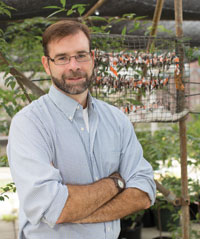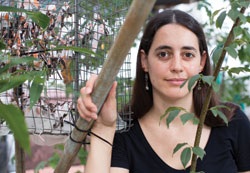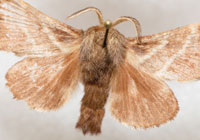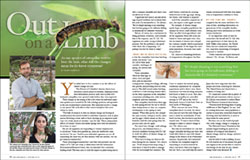Out on a Limb
As one species of caterpillar tries to beat the heat, what will the changes mean for its forest ecosystem?
You didn't have to be a scientist to see the effects of climate change last year.
The District of Columbia's famous cherry trees bloomed a month ahead of schedule. Mammals broke their hibernation patterns early. And in John Lill's backyard, caterpillars were spotted weeks before they were expected.
These changes in the timing of life cycle events for individual organisms sparked new research by Dr. Lill, a biology professor and specialist in the area of plant-insect interactions. He's interested in how a change in one species' life cycle affects other insects and plants that move within its circle.
"The bulk of research to date on climate change and biological manifestations has mostly looked at individual responses, such as plant species flowering a week early or birds showing up on migratory pathways two weeks ahead of schedule," says Dr. Lill. "These independent effects of warmer winters and earlier springs have been documented for at least 10 years."
But not all organisms are responding to warmer temperatures in synchrony. "Some have speeded up, some are unaffected, some are slowed," he says. "And because individual organisms are not all responding the same way, yet they interact with one another, you can get temporal mismatches."
Those chronological mismatches—and what they portend—are the subject of Dr. Lill's new study, a collaboration with the Smithsonian Environmental Research Center, that was launched with a university funding award. The team aims to track the impact on plant-eating insects after a common caterpillar and cherry trees are driven out of sync.

Dr. Lill and Ms. Abarca are exploring the impact of climate change on the tent caterpillar and what that means for other species.
Photos by Jessica McConnell Burt

"I appreciate how insects can take advantage of good conditions and accelerate their life cycles. I'm fascinated by it," Dr. Lill says. "But it's deeply alarming to see something that has been going on for millennia shifting so dramatically. It's definitely worrisome."
Nature, of course, has a mechanism for fixing problems: evolution. And normally that is the response, says Dr. Lill. "All organisms are under strong evolutionary pressure. But the problem is the speed with which this is happening—it's perhaps too fast for them to adapt."
"What we've been noticing is that the caterpillars have been hatching earlier and earlier," says Dr. Lill of what many consider a harbinger of spring, the eastern tent caterpillar.
These caterpillars, which lay their eggs on cherry trees and apple trees, play an important ecological role: eating tree foliage, affecting tree growth, and providing food for other insects. The shift toward earlier hatching could have a wide-reaching domino effect on the other organisms in the caterpillars' community, including trees, other insects, songbirds, and even mammals.
Tent caterpillars hatch from their eggs in early spring and use the sun to elevate their temperatures so they can complete development in late spring or early summer. When fully grown, the caterpillars spin cocoons, emerge as moths, mate, and lay eggs—which remain on the tree branches until the next spring when the process starts all over again.
Too much heat, though, could unhinge the process, says Mariana Abarca, a doctoral candidate working with Dr. Lill to study the effects of climate change on these caterpillars.
"They have to hang out there in the trees during the hot summer," Ms. Abarca says. "If the temperatures keep rising, I don't know if they'll be able to manage with the increasingly hot summers. The mild winters could also be stressing them because at the egg stage, during the winter, cold weather is required."
And if the caterpillars respond out of sync, the impact could ripple outward.
For example, if climate change sparks larger caterpillar populations the demand for leaves could defoliate trees. That can affect local agriculture—and all the organisms whose life cycles are linked to cherry and apple trees. Also, the excrement of eastern tent caterpillars contains cyanide, which is poisonous to some animals. So the larger the caterpillar population, the more toxic material produced.
Ms. Abarca is examining databases of temperatures throughout the East Coast to analyze the natural spring conditions experienced by caterpillar populations and to detect sites where asynchrony between hatching and plant bud bursts is likely to occur. She's also watching caterpillars in controlled settings at GW and in the wild at Maryland's Seneca Creek State Park, an hour north of Washington.
What concerns her most? If the caterpillars hatch too early, the cherry trees may not have the early foliage the insects needs for nourishment. If they hatch too late, the tree leaves may have turned toxic. "I want to know if they manage to adapt to climate change or not," Ms. Abarca says.
She's also on the lookout for cues that trigger caterpillar hatching and traits that would allow them to cope with climate change in the absence of an evolutionary response. In particular, she's interested in whether the caterpillars might be responding to an aroma emitted by cherry tree leaves when trees begin to leaf out. Such a cue could help the insects remain synchronized with their host plants even as temperatures continue to warm.
 By the time Ms. Abarca completes her doctorate she'll have five years of data, including information on generations of the caterpillar families, offering short-term information on evolutionary tendencies.
By the time Ms. Abarca completes her doctorate she'll have five years of data, including information on generations of the caterpillar families, offering short-term information on evolutionary tendencies.
It's an important cache of data for researchers like herself and Dr. Lill, who must spend much of their time in the field. Unlike other nations, the United States has not conducted comprehensive, long-term monitoring of biological responses to weather.
"Other countries have good historical datasets," Dr. Lill says. "In Britain and Japan they have long-term data that people have been collecting for centuries. The United States just doesn't have a tradition of doing that."
U.S. researchers instead rely on plenty of fieldwork and sometimes eclectic sources—Dr. Lill has even referred to author Henry David Thoreau's botanical observations.
"Thoreau noted flowering times of spring wildflowers in New England," he says, "and by tracking those exact same populations a century or more later, researchers found that flowering times had shifted by as much as three weeks for some species."
But here, too, in the world of people who study change, change is creeping in.
The National Science Foundation last summer began building an open-access database of ecological data linked to climate change, land-use change, and invasive species.
And the field of study is shifting. In 1992, Dr. Lill received one of the nation's first graduate degrees in the nascent field of conservation biology. At the time, he says, climate change wasn't even discussed.

